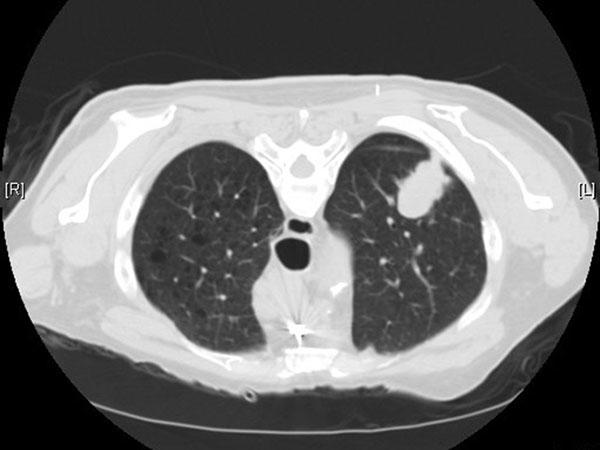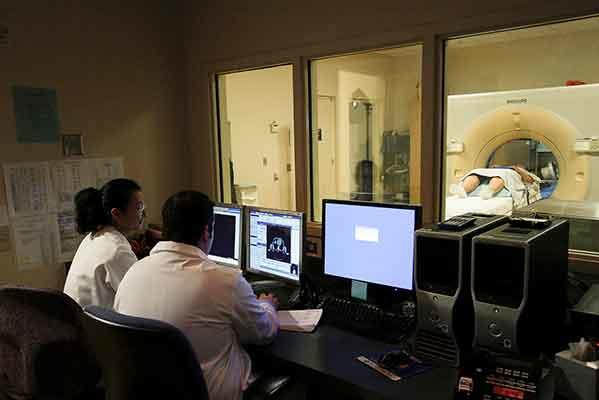Lung Cancer Screening Pilot Reveals Challenges, Growing Pains
, by NCI Staff
A demonstration project by the US Veterans Health Administration (VHA) is highlighting some of the complexities and challenges associated with the expansion of lung cancer screening in the United States.
In 2013, the US Preventive Services Task Force (USPSTF) recommended that people at high risk for lung cancer because of their age and smoking history undergo annual lung cancer screening with low-dose computed tomography (CT).
In a new report published January 30 in JAMA Internal Medicine, the VHA team documented their experience with a 3-year demonstration project to screen high-risk patients for lung cancer.
A modest number of people were diagnosed with early-stage lung cancer as a result of being screened with low-dose CT, they reported. But they also described a number of challenges they confronted in conducting the program, including struggles with identifying patients who were eligible for screening, coordinating the screening and post-screening follow-up processes, and handling incidental findings—pulmonary nodules or other issues identified during screening that aren’t lung cancer but that may require clinical follow-up.
The demonstration project was launched in an effort to better understand how a comprehensive screening program for lung cancer would operate in the VHA and outside the confines of a clinical trial, explained the study's lead investigator, Linda Kinsinger, M.D., M.P.H., of the VHA National Center for Health Promotion and Disease Prevention in Durham, North Carolina.
"We wanted to see how [screening] would look in regular, everyday practice," Dr. Kinsinger said. "How would we identify who should be screened, engage them in shared decision-making, and get them into screening? How consistent would our radiologists be? That was all part of it."
From a Trial to a Recommendation to the Clinic
The VHA's demonstration project was launched shortly after the USPSTF issued its recommendation, which was largely based on a finding from the NCI-funded National Lung Screening Trial (NLST): a 20% reduction in lung cancer deaths among current and former heavy smokers aged 55 to 80 years screened with low-dose CT.
On the heels of the USPSTF recommendation, hospitals across the country began launching lung cancer screening programs. The number of new programs increased dramatically following a decision by the Centers for Medicare and Medicaid Services (CMS) in early 2015 to cover low-dose CT screening for high-risk Medicare beneficiaries.
In just the past 2 years, in fact, more than 2,500 facilities have registered with the American College of Radiology's (ACR) Lung Cancer Screening Registry. To be eligible for Medicare reimbursement, facilities must report data from their screening programs to a CMS-approved registry like the one established by the ACR.
The registry is intended to help measure the quality of radiologists' performance in interpreting CT scans and provide information on how they compare with their peers. Those kinds of efforts are important, Dr. Kinsinger said, because conducting screening as part of a clinical trial—which has highly standardized processes for everything from patient recruitment to analyzing imaging studies—is far different from doing so in the community.
"It takes lots of communication," she continued. "It's not primary care alone. It's not [pulmonology] alone. It's not radiology alone. It takes all of those services, and others, to make it work."
The 3-Year Experience
The demonstration project was conducted at eight VHA centers around the country. To conduct it, the research team developed an implementation guide for staff, patient education materials, a database to track people who have undergone screening, and guidelines for radiology staff on interpreting CT scans and for patient follow-up. Each participating center also had a full-time staff person to serve as a coordinator for their screening program.
The effort started with a baseline pool of more than 93,000 VHA patients who, based on a medical records review, met the screening criteria for age and also lacked other disqualifying conditions.
But after all was said and done, only 2,100 patients were actually screened. The pool of eligible patients was whittled down significantly based on numerous factors. More than 35,000 patients, for example, were not offered screening because there was not enough information in their medical records to calculate the number of "pack years" they had smoked. According to the USPSTF recommendation, a heavy smoking history means 30 or more pack years of smoking.
In everyday practice, however, making such a calculation can be difficult, Dr. Kinsinger said.
"People who smoke don't track that sort of thing as closely as you think they would, and they don't smoke at the same level for years and years," she said.
Paul Doria-Rose, Ph.D., of the Healthcare Delivery Research Program in NCI's Division of Cancer Control and Population Sciences, agreed that identifying those who meet the criteria can be a difficult task.
Accurate information on pack years of smoking is not captured in most medical records, Dr. Doria-Rose explained. He cited pilot studies of lung cancer screening performed in the NCI-funded Cancer Research Network, which found that reports of smoking history were often missing.
"A primary care physician may know that his or her patient is a current or former smoker. But with the competing demands of what they may be trying to accomplish during office visits, it can be very hard to get the information they need to determine if somebody is eligible for screening," he said.
In the VHA project, of the approximately 4,300 patients who did meet the screening criteria, nearly 1,800 declined. The reasons why VHA patients chose not to be screened were not documented, but the study authors suggested a variety of potential reasons, including concern about what the screening might reveal, concerns about radiation exposure, and the effort required to undergo screening.
Nearly 60% of people screened had a positive result—meaning the scan identified a lung nodule or other finding that required follow-up—after their first scan, more than twice the rate of positive results seen after the first round of screening in NLST. This higher rate may be due, in part, "to the older age and heavier smoking history of veterans screened," the VHA team reported.
Overall, 31 lung cancers were diagnosed, 20 of which were stage 1. Nearly 40% of patients screened had an incidental finding, including emphysema or coronary calcifications.
Although not all positive results require follow-up, "inclusion of these findings in reports of [low-dose CT] scan results requires a health care professional's time to determine if additional testing is necessary," the VHA team wrote.
Insights on Lung Cancer Screening Trends
Two new studies provide insights into how lung cancer screening in the United States is evolving. Both studies used data from the National Health Interview Survey to compare patterns of screening with low-dose CT for lung cancer in 2010 with those in 2015.
The first study, published January 30 in JAMA Internal Medicine, showed a modest overall increase in the number of people who underwent low-dose CT scans for lung cancer during the 5-year time period (2.1%, up from 1.3%). This included a small increase in screening among never-smokers (1.2%, up from 0.8%), but more substantial increases among both low-risk smokers (2.7%, up from 1.5%) and high-risk smokers (5.8%, up from 2.9%).
The second study, published February 2 in JAMA Oncology, showed a somewhat different trend, with small increases among both low-risk smokers and high-risk smokers. The researchers also estimated that, overall, in 2015 only 3.9% of those who met the criteria for screening actually underwent screening.
The finding, the study authors wrote, "underscores the need to educate clinicians and smokers about the benefit and risks of lung cancer screening for informed decision making."
Results 'Not Unexpected'
Clinicians and health care staff working with lung cancer screening programs at their own institutions are likely very familiar with the kinds of findings that the VHA reported, said Lynn Tanoue, M.D., who directs the Lung Screening and Nodule Program at Yale Cancer Center.
"What [the VHA] is reporting is the initial experience for almost everybody," Dr. Tanoue said. "Until people really started doing lung cancer screening, and began to understand the challenges of doing it properly, you couldn’t have known what it was going to be like."
Many institutions are still learning how to handle the "host of logistical and operational challenges associated with lung cancer screening," Denise Aberle, M.D., of the David Geffen School of Medicine at UCLA and an NLST principal investigator, recently wrote.
For example, Dr. Aberle explained, a "moderate number" of people continue to be referred for screening "who satisfy neither the age or smoking criteria nor have undergone shared decision-making."
What is Shared Decision-Making?
Shared decision-making is an important component of USPSTF recommendations on lung cancer screening.
This process involves a discussion with patients about the potential benefits and harms of screening; the type of follow-up diagnostic testing that could be involved; and the risks of overdiagnosis, false-positive results, and exposure to radiation from screening. It should also include discussions about smoking cessation.
NCI has developed a Patient and Physician Guide on the NLST results to help facilitate shared decision-making sessions.
This rocky start has led some in the medical community to express doubt about whether lung cancer screening is ready for widespread use.
In an editorial that accompanied the VHA report, Rita Redberg, M.D., of the University of California, San Francisco, and Patrick O'Malley, M.D., of the Uniformed Services University of the Health Sciences in Bethesda, Maryland, said it was still an open question whether the benefits of broader lung cancer screening outweigh its harms.
That question, as well as whether lung cancer screening with low-dose CT "is a wise investment of [the] considerable resources required for screening and training, remains to be adequately evaluated with robust economic and utility analyses," they wrote. "In the meantime, it is critically important to limit screening to the patients most likely to benefit, in a fully informed, shared-decision manner."
Despite the initial challenges, Dr. Tanoue said that she has no doubt that screening for lung cancer will save lives.
"The data from NLST were very clear," she said. "We should accept that there is benefit and choose the right population to screen."
Important improvements have already been made, she continued. One of the most important has been the establishment and expanding use of the ACR Lung-RADS algorithm for assessing lung nodules identified on CT scans, she said.
Lung-RADS uses a combination of factors, including the size of nodules discovered on CT and how they change over time (on future scans), and their consistency (e.g., solid or somewhat hazy), to identify a positive result.
Several studies have now shown that this algorithm "eliminates a lot of false-positives without increasing the rate of false-negatives," Dr. Tanoue said. She pointed in particular to a study that showed a dramatic reduction in false-positive results when the Lung-RADS criteria were used retrospectively to assess the CT scans performed in NLST.
Several research groups have also developed new risk-prediction models to help better identify people who are at the highest risk of lung cancer and would benefit the most from screening.
These models incorporate other factors beyond age and pack years smoked, she explained, such as sex, socioeconomic status, and family history. But the models will have to be assessed in "rigorously designed studies" before they can be used in practice, Dr. Tanoue said.
Overall, the VHA's demonstration project and the experiences with screening at centers across the country raise a key point that is sometimes overlooked, Dr. Doria-Rose said.
"It really gets to the basic idea that screening is not a single test, it's a process," he said.
Like Dr. Tanoue, Dr. Aberle expressed confidence that things will improve.
"Although still nascent in implementation, lung cancer screening in the [United States] will surely persist," she wrote. "The ultimate approach to early lung cancer diagnosis is only beginning to emerge, and awaits the benefits of time and the wisdom of experience."

